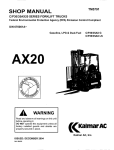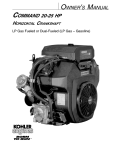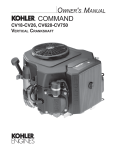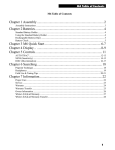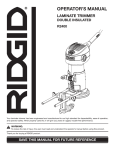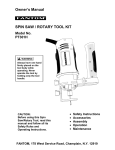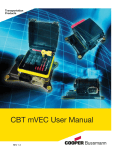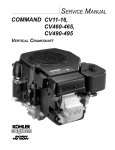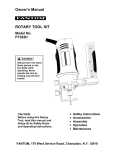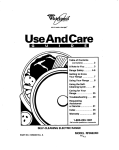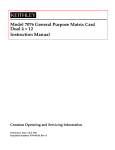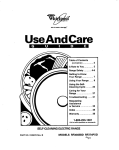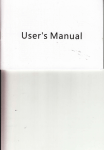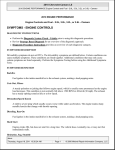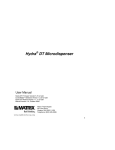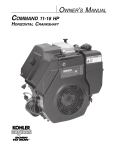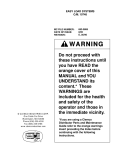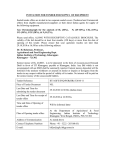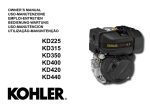Download a WARNING - Small Engine Warehouse
Transcript
Kohler Owner’s Manual Page 2 Basic Fuel Injection System Installation Page 22 OWNER'S MANUAL COMMAND SERIES CVI 7-CV26, CV675-740 VERTICAL CRANKSHAFT Safety Precautions To insure safe operation please read the following statements and understand their meaning. Also refer to your equipment owner's manual for other important safety information. This manual contains safety precautions which are explained below. Please read carefully. a WARNING Warning is used to indicate the presence of a hazard that can cause severe personal injury, death, or substantial property damage if the warning is ignored. a CAUTION Caution is used to indicate the presence of a hazard that will or can cause minor personal injury or property damage if the caution is ignored. NOTE Note is used to notify people of installation, operation, or maintenance information that is important but not hazard-related. For Your Safety! These precautions should be followed at all times. Failure to follow these precautions could result in injuy to yourself and others. a WARNING I AWARNING Explosive Fuel can cause fires and severe burns. Rotating Parts can cause severe injury. Stop engine before filling fuel tank. Stay away while engine is in oDeration. Explosive Fuel! Gasoline is extremely flammable and its vapors can explode if ignited. Store gasoline only in approved containers, in well ventilated, unoccupied buildings, away from sparks or flames. Do not fill the fuel tank while the engine is hot or running, since spilled fuel could ignite if it comes in contact with hot parts or sparks from ignition. Do not start the engine near spilled fuel. Never use gasoline as a cleaning agent. ACAUTION Do not touch engine while operating or just after stopping. I Hot Parts! Engine components can get extremely hot from operation. To prevent severe burns, do not touch these areas while the engine is running, or immediately after it is turned off. Never operate the engine with heat shields or guards removed. I Electrical Shock can cause injury. Do not touch wires while engine is running. Electrical Shock! Never touch electrical wires or components while the engine is running. They can be sources of electrical shock. 2 Hot Parts can cause severe burns. Rotating Parts! Keep hands, feet, hair, and clothing a way from all moving parts to prevent injury. Never operate the engine with covers, shrouds, or guards removed. I a WARNING I California ProDosition 65 Warninu Engine exhaust from this product contains chemicals known to the State of California to cause cancer, birth defects, or other reproductive harm. Safety Precautions (Cont .) a WARNING a WARNING a WARNING - Accidental Starts can cause severe injury or death. Carbon Monoxide can cause severe nausea, fainting or death. Explosive Gas can cause fires and severe acid burns. Disconnect and ground spark plug leads before setvicina. Do not operate engine in closed or Charge battey only in a well ventilated area. Keep sources of ignition away. Accidental Starts! Disabling engine, Accidental starting can cause severe injury or death, Before working on the engine or equipment, disable the engine as follows: 1) Disconnect the spark plug lead(s). 2) Disconnect negative (-) battery cable from battery. confined area. Lethal Exhaust Gases! Engine exhaust gases contain poisonous carbon monoxide. Carbon monoxide is odorless, colorless, and can cause death if inhaled. Avoid inhaling exhaust fumes, and never run the engine in a closed building or confined area. Explosive Gas! Batteries produce explosive hydrogen gas while being charged. To prevent a fire or explosion, charge batteries only in well ventilated areas. Keep sparks, open flames, and other sources of ignition away from the battery at all times. Keep batteries out of the reach of children. Remove all je welry when servicing batteries. Before disconnecting the negative (-)ground cable, make sure all switches are OFF: If ON, a spark will occur at the ground cable terminal which could cause an explosion if hydrogen gas or gasoline vapors are present. Congratulations- You have selected a fine four-cycle, twin cylinder, air-cooled engine. Kohler designs long life strength and on-the-job durability into each engine...making a Kohler engine dependable...dependability you can count on. Here are some reasons why: Efficient overhead valve design, and pressure lubrication provide maximum power, torque, and reliability under all operating conditions. Dependable, maintenance-free electronic ignition ensures fast, easy starts time after time. Kohler engines are easy to service. All routine service areas (like the dipstick and oil fill, air cleaner, spark plugs, and carburetor) are easily and quickly accessible. Parts subject to the most wear and tear (like the cylinder liner and camshaft) are made from precision formulated cast iron. Every Kohler engine is backed by a worldwide network of over 10,000 distributors and dealers. Service support is just a phone call away. Call 1-800-544-2444 (U.S. & Canada) for Sales & Service assistance. I To keep your engine in top operating condition, follow the maintenance procedures in this manual. 3 Fuel Pump Engine Identification Label \ Air Intake Screen \ Oil Fill/ Blower Housing Fuel Filter Oil Filter Plug .Air Cleaner Cover Breather Oil Separator :igure 1. Typical Command Vertical Shaft Engine (CV17-25, CV675-740). Oil F:ilI/Diostick Ignition Coil Igniition Coil \ ’ Fuel Injector Throttle Body Intake Manifold Ygure 2. CV26 Command Vertical Shaft Engine. 4 Fuel Injector Fuel Recommendations Oil Recommendations Using the proper type and weight of oil in the crankcase is extremely important. So is checking oil daily and changing oil regularly. Failure to use the correct oil, or using dirty oil, causes premature engine wear and failure. Oil Type Use high quality detergent oil of API (American Petroleum Institute) service class SGg SH, SJ or higher. Select the viscosity based on the air temperature at the time of operation as shown in the following table. R E C O M M E N D E D S A E V I S C O S I T Y GRADES a WARNING: Explosive Fuel! Gasoline is extremely flammable and its vapors can explode if ignited. Store gasoline only in approved containers, in well ventilated, unoccupied buildings, a way from sparks or flames. Do not fill the fuel tank while the engine is hot or running, since spilled fuel could ignite if it comes in contact with hot parts or sparks from ignition. Do not start the engine near spilled fuel. Never use gasoline as a cleaning agent. General Recommendations Purchase gasoline in small quantities and store in clean, approved containers. A container with a capacity of 2 gallons or less with a pouring spout is recommended. Such a container is easier to handle and helps eliminate spillage during refueling. v I OF -50 ‘C’30 -d@ I I I 0 20 35 -40 0 I I I 60 80 I 4b lb I I I 20 1 I 30 do I Do not use gasoline left over from the previous season, to minimize gum deposits in your fuel system and to insure easy starting. 40 TEMPERATURE RANGE EXPECTED BEFORE NEXT OIL CHANGE Do not add oil to the gasoline. *Use of synthetic oil having 5W-20 or 5W-30 rating is acceptable, up to 4OoF. **Synthetic oils will provide better starting in extreme cold (below -1OOF). Do not overfill the fuel tank. Leave room for the fuel to expand. :igure 3. Viscosity Grades Table. Fuel Type NOTE: Using other than service class SG, SH, SJ or higher oil or extending oil change intervals longer than recommended can cause engine damage. A logo or symbol on oil containers identifies the API service class and SAE viscosity grade. See Figure 4. For best results use only clean, fresh, unleaded gasoline with the pump sticker octane rating of 87 or higher. In countries using the Research method, it should be 90 octane minimum. Unleaded gasoline is recommended as it leaves less combustion chamber deposits. Leaded gasoline may be used in areas where unleaded is not available and exhaust emissions are not regulated. Be aware however, that the cylinder heads may require more frequent se rvice. Gasoline/Alcohol blends Gasohol (up to 10% ethyl alcohol, 90% unleaded gasoline by volume) is approved as a fuel for Kohler engines. Other gasoline/alcohol blends are not approved. Figure 4. Oil Container Logo. Refer to “Maintenance Instructions” beginning on page 9 for detailed oil check, oil change, and oil filter change procedures. Gasoline/Ether blends Methyl Tertiary Butyl Ether (MTBE) and unleaded gasoline blends (up to a maximum of 15% MTBE by volume) are approved as a fuel for Kohler engine. Other gasoline/ether blends are not approved. 5 Engine Identification Numbers Model Designation When ordering parts, or in any communication involving an engine, always give the Model, Specification, and Serial Numbers of the engine. Model CV2OS for example: C designates Command engine, V designates vertical crankshaft, and 20 designates horsepower. Some model numbers (CV675) use the approximate displacement rather than horsepower. A letter suffix designates a specific version as follows: The engine identification numbers appear on a decal (or decals) affixed to the engine shrouding. Include letter suffixes, if there are any. Suffix S ST Record your engine identification numbers on the identification label below (Figure 5) for future reference. Designates Electric Start ElectridRetractable Start Operating Instructions Also read the operating instructions of the equipment this engine powers. IMPORTANT ENGINE INFORMATION THIS ENGINE MEETS U.S. EPA 2004 AND CALIFORNIA 2006 AND LATER EMISSION CONTROL REGULATIONS FOR SI SORE* Pre-Start Checklist Check oil level. Add oil if low. Do not overfill. FAMILY DISPL. (CC) MODEL NO. Check fuel level. Add fuel if low. SPEC. NO. SERIAL NO. aN11236 Check cooling air intake areas and external surfaces of engine. Make sure they are clean and unobstructed. EMISSION COMPLIANCE PERIOD: E PA: CARB: THIS ENGINE IS CERTIFIED TO OPERATE ON: REFER TO OWNER'S MANUAL FOR SAFETY, MAINTENANCE SPECS AND ADJUSTMENTS. Check that the air cleaner components and all shrouds, equipment covers, and guards are in place and securely fastened. FOR SALES/SERVICE IN US/CANADA, CALL: 1-800-544-2444 www. kohlerengines.com Check that any clutches or transmissions are disengaged or placed in neutral. This is especially important on equipment with hydrostatic drive. The shift lever must be exactly in neutral to prevent resistance which could keep the engine from starting. u KOHLER CO. KOHLER, WISCONSIN USA *Small Off-Road Engines :igure 5. Engine Identification Label. WARNING: Lethal Exhaust Gases! Engine exhaust gases contain poisonous carbon monoxide. Carbon monoxide is odorless, colorless, and can cause death if inhaled. Avoid inhaling exhaust fumes, and never run the engine in a closed building or confined area. The Emission Compliance Period referred to on the Emission Control or Air Index label indicates the number of operating hours for which the engine has been shown to meet Federal and CARB emission requirements. The following table provides the Engine Compliance Period (in hours) associated with the category descriptor found on the certification label. Emission Compliance Period (Hours) I EPA CARB Category c 1250 hours Moderate 125 hours I Category B 500 hours I Category A 1000 hours Intermediate Extended 250 hours 500 hours Exhaust Emission Control System for models CV17,18,20,22,23,25,675,730,740is EM. Exhaust Emission Control System for model CV26 is EM, 02S, ECM, MFI. 6 Cold Weather Starting Hints I 1. Be sure to use the proper oil for the temperature expected. See Figure 3 on page 5. 2. Declutch all possible external loads. 3. Be sure the battery is in good condition. A warm battery has much more starting capacity than a cold battery. 4. Use fresh winter grade fuel. NOTE: Winter grade gasoline has higher volatility to improve starting. Do not use gasoline left over from summer. Starting 1. Place the throttle control midway between the “slow” and “fast” positions. Place the choke control (non-EFI engines only) into the “on” position. 2. Start the engine by activating the key switch. Release the switch as soon as the engine starts. NOTE: Do not crank the engine continuously for more than 10 seconds at a time. If the engine does not start, allow a 60 second cool down period between starting attempts. Failure to follow these guidelines can burn out the starter motor. Stopping 1. Remove the load by disengaging all PTO driven attachments. 2. For Carbureted Engines Without A Shutdown Solenoid: Move the throttle to the “slow” or “low” idle position. Allow the engine to run at idle for 30-60 seconds; then stop the engine. For Carbureted Engines Equipped With A Shutdown Solenoid: Position the throttle control between half and full throttle; then stop the engine. For EFI Engines: Move the throttle to the “slow” or “idle” position; turn key “off to stop engine. I’ Battery NOTE: Upon start-up, a metallic ticking may occur. This is caused by hydraulic lifter leakdown during storage. Run the engine for 5 minutes. The noise will normally cease in the first minute. If noise continues, run the engine at mid-throttle for 20 minutes. If noise persists, take the engine to your local Kohler Service outlet. A 12 volt battery is normally used. Refer to the operating instructions of the equipment this engine powers for specific battery requirements. NOTE: If the engine develops sufficient speed to disengage the starter but does not keep running (a false start), engine rotation must be allowed to come to a complete stop before attempting to restart the engine. If the starter is engaged while the flywheel is rotating, the starter pinion and flywheel ring gear may clash, resulting in damage to the starter. Angle of Operation This engine will operate continuously at angles up to 25”. Check oil level to assure crankcase oil level is at the “FULL” mark on the dipstick. If the starter does not turn the engine over, shut off starter immediately. Do not make further attempts to start the engine until the condition is corrected. Do not jump start using another battery (refer to “Battery”). See your Kohler Engine Service Dealer for service assistance. NOTE: Do not operate this engine continuously at angles exceeding 25” in any direction. Engine damage could result from insufficient lubrication. Carbureted Engines Only: 3. For a Cold Engine - Gradually return the choke control to the “off” position after the engine starts and warms up. The engine/equipment may be operated during the warm-up period, but it may be necessary to leave the choke partially on until the engine warms If the battery charge is not sufficient to crank the engine, recharge the battery (see page 14). Operating Refer to the operating instructions of the equipment this engine powers. Because of equipment design or application, there may be more stringent restrictions regarding the angle of operation. Cooling NOTE: If debris builds up on the grass screen or other cooling areas, stop the engine immediately and clean. Operating the engine with blocked or dirty air intake and cooling areas can cause extensive damage due to overheating. See Clean Air Intake/Cooling Area, page 13. UP. 4. For a Warm Engine - Return choke to “off” position as soon as engine starts. 7 WARNING: Hot Parts! Engine components can get extremely hot from operation. To prevent severe burns, do not touch these areas while the engine is running, or immediately after it is turned off. Never operate the engine with heat shields or guards removed. Engine Speed NOTE: Do not tamper with the governor setting to increase the maximum engine speed. Overspeed is hazardous and will void the engine warranty. The maximum allowable high idle speed for these engines is 3750 RPM, no load. Maintenance Instructions Maintenance, repair, or replacement of the emission control devices and systems, which are being done at the customers expense, may be performed by any non-road engine repair establishment or individual. Warranty repairs must be performed by an authorized Kohler service outlet. WARNING: Accidental Starts! Disabling engine, Accidental starting can cause severe injury or death, Before working on the engine or equipment, disable the engine as follows: I) Disconnect the spark plug lead@).2) Disconnect negative (-)battery cable from battery. Maintenance Schedule These required maintenance procedures should be performed at the frequency stated in the table. They should also be included as part of any seasonal tune-up. I Frequency I Maintenance Required Daily Or Before Starting Engine Fill fuel tank. Check oil level. Check air cleaner for dirty’, loose, or damaged parts. Check air intake and cooling areas, clean as necessary’. Every 25 Hours Service precleaner element’. Check oil cooler, clean as necessarv’. Every 100 Hours I Every 2oo Hours Every 250 Hours Replace heavy-duty air cleaner element and check inner element’. Annually or Every 500 Hours Have bendix starter drive serviced 2. Have solenoid shift starter disassembled and cleaned 2. Every 1500 Hours 8 I Replace air cleaner element’. Change oil (more frequently under severe conditions). Remove cooling shrouds and clean cooling areas’,3. Check oil cooler fins. clean as necessarv (if eauitmedl Change oil filter. Check spark plug condition and gap. Replace fuel filter’ (EFI engines). I Check Oil Level The importance of checking and maintaining the proper oil level in the crankcase cannot be overemphasized. Check oil BEFORE EACH USE as follows: 1. Make sure the engine is stopped, level, and is NOTE: To prevent extensive engine wear or damage, always maintain the proper oil level in the crankcase. Never operate the engine with the oil level below the “ADD” mark or over the “FULL” mark on the dipstick. cool so the oil has had time to drain into the sump. Oil SentryTM Some engines are equipped with an optional Oil SentryTMoil pressure switch. If the oil pressure drops below an acceptable level, the Oil SentryTMwill either shut off the engine or activate a warning signal, depending on the application. 2. To keep dirt, debris, etc., out of the engine, clean the area around the dipstick before removing it. 3. Unthread and remove the dipstick; wipe oil off. Reinsert the dipstick into the tube and rest the cap on the tube. Do not thread the cap onto the tube. See Figure 6. NOTE: Make sure the oil level is checked BEFORE EACH USE and is maintained up to the “FULL” mark on the dipstick. This includes engines equipped with Oil SentryTM. Change Oil and Filter, Service Oil Cooler Change Oil Change oil after every 100 hours of operation (more frequently under severe conditions). Refill with service class SG, SH, SJ or higher oil as specified in the “Viscosity Grades” table (Figure 3) on page 5. I :igure 6. Checking Oil Level. 4. Pull the dipstick out and check the oil level. The oil level should be up to, but not over, the “FULL” mark on the dipstick. See Figure 7. Change the oil while the engine is still warm. The oil will flow more freely and carry away more impurities. Make sure the engine is level when filling, checking, or changing the oil. Change the oil as follows (see Figure 8): 1. To keep dirt, debris, etc., out of the engine, clean the area around the oil fill cap/dipstick before removing it. 2. Remove one of the oil drain plugs and the oil fill I I’ FulII’ Mark Operating Range I igure 7. Oil Level Dipstick. cap/dipstick. Be sure to allow ample time for complete drainage. 3. Reinstall the drain plug. Make sure it is tightened to 13.6 N-m (10 ft. Ib.) torque. 4. Fill the crankcase, with new oil of the proper type, to the “FULL” mark on the dipstick. Refer to “Oil Type” on page 5. Always check the level with the dipstick before adding more oil. 5. If the level is low, add oil of the proper type, up to the “FULL” mark on the dipstick. (Refer to “Oil Type” on page 5.) Always check the level with the dipstick before adding more oil. 9 5. Reinstall the oil fill cap/dipstick and tighten securely. NOTE: To prevent extensive engine wear or damage, always maintain the proper oil level in the crankcase. Never operate the engine with the oil level below the “ADD” mark or over the “FULL” mark on the dipstick. I Figure 9. Crankcase Mounted Oil Cooler. To service the crankcase mounted oil cooler, clean off the outside fins with a brush or with compressed air. I Figure 10. Blower Housing Mounted Oil Cooler. I Figure 8. Oil Drain Plugs and Oil Filter. Service Oil Cooler Some engines are equipped with an oil cooler. One style of oil cooler mounts on the engine crankcase and has the oil filter on it (see Figure 9). The other style of oil cooler is mounted on the blower housing (see Figure lo), separate from the oil filter. To service the blower housing mounted style oil cooler, clean the outside of fins with a brush. See Figure 10. Remove the two screws holding the cooler unit to the blower housing. Tilt the cooler downward as shown in Figure 11. Clean the inside of the cooler with a brush, as shown in Figure 11, or with compressed air. After cleaning, reinstall the oil cooler to the blower housing with the two mounting screws. Inspect and clean oil cooler every 25 hours of operation (more frequently under severe conditions). Oil cooler must be kept free of debris. I Figure 11. Cleaning Blower Housing Mounted Oil Cooler. 10 Change Oil Filter Replace the oil filter at least every other oil change (every 200 hours of operation). Always use a genuine Kohler oil filter, Part No. 12 050 OI-S. 7. Reinstall the drain plug. Make sure it is tightened to 13.6 N-m (10 ft. Ib.) torque. 8. Fill the crankcase with new oil, of the proper type, to the “FULL” mark on the dipstick. Replace the oil filter as follows: 9. Test run the engine to check for leaks. Stop the engine, allow a minute for the oil to drain down, and recheck the level on the dipstick. Make sure oil level is up to but not over the “FULL mark on the dipstick. 1. Drain the oil from the engine crankcase. 2. Allow the oil filter to drain. 3. Before removing the oil filter, clean the area around the oil filter to keep dirt and debris out of the engine. Remove the old filter. Wipe off the surface where the filter mounts. 4. Place a new replacement filter in a shallow pan with the open end up. Pour new oil, of the proper type, in through the threaded center hole. Stop pouring when the oil reaches the bottom of the threads. Allow a minute or two for the oil to be absorbed by the filter material. 5. Put a drop of oil on your fingertip and wipe it on the rubber gasket. 6. Install the new oil filter to the filter adapter or oil cooler. Turn the oil filter clockwise until the rubber gasket contacts the filter adapter or oil cooler, then tighten the filter an additional 2/3 to 1 turn. Service Precleaner and Air Cleaner Element These engines are equipped with a replaceable, high density paper air cleaner element. An optional heavyduty air cleaner system is also available. Most engines are also equipped with an oiled, foam precleaner which surrounds the paper element. See Figures 12 and 13. Check the air cleaner daily or before starting the engine. Check for a buildup of dirt and debris around the air cleaner system. Keep this area clean. Also check for loose or damaged components. Replace all bent or damaged air cleaner components. NOTE: Operating the engine with loose or damaged air cleaner components could allow unfiltered air into the engine causing premature wear and failure. Air Cleaner Base Spitback Cup Cup Gasket Air Cleaner Cover \ Knob Seal Element Cover Nut \ Element Cover / Knob ‘igure 12. Air Cleaner System Components - Type A (Standard). 11 Element Cover Nut Element \ I’ U \ Rubber Seal Stud CV26 EFI Air Cleaner Base Air Cleaner Base :igure 13. Air Cleaner System Components - Type B (Commercial Mower). Service Precleaner If so equipped, wash and reoil the precleaner every 25 hours of operation (more often under extremely dusty or dirty conditions). Service Paper Element Every 100 hours of operation (more often under extremely dusty or dirty conditions), replace the paper element. 1. Loosen the cover retaining knob and remove the cover. 1. Loosen the cover retaining knob and remove the cover. 2. Remove the precleaner from the paper element. 2. Clean the area around the element to prevent debris from getting in the engine when element is removed. 3. Wash the precleaner in warm water with detergent. Rinse the precleaner thoroughly until all traces of detergent are eliminated. Squeeze out excess water (do not wring). Allow the precleaner to air dry. 3. Remove the element cover wing nut, element cover, and paper element with precleaner. Separate the precleaner from the element and service as necessary. 4. Saturate the precleaner with new engine oil. Squeeze out all excess oil. 4. Do not was the paper element or use pressurized air, as this will damage the element. Replace a dirty, bent, or damaged element with a genuine Kohler element. Handle new element carefully; do not use if the sealing surfaces are bent or damaged. 5. Reinstall the precleaner over the paper element. 6. Reinstall the air cleaner cover. Secure cover with the cover retaining knob. 7. When precleaner replacement is necessary order genuine Kohler Parts. I TYPeA I Type B I I CV17-CV23 24083024 45 083 01-S CV675, CV25, CV26 I I 24083054 45 083 01-S I I 5. When servicing the air cleaner, check the air cleaner base. Make sure it is secured and not bent or damaged. Also, check the element cover for damage or improper fit. Replace all damaged air cleaner components. 6. Check the condition of the rubber seal on the air cleaner stud. If it is worn, damaged, or its condition is questionable in any way, replace it. 12 7. Reinstall the paper element, precleaner, element 6. Install the new inner element, Kohler Part No. 25 083 04-Sfollowed by the outer element, Kohler Part No. 25 083 014.Slide each fully into place in the air cleaner housing. cover, element cover wing nut and air cleaner cover. Secure cover with the cover retaining knob. 8. When element replacement is necessay, order genuine Kohler Parts. I TweA I Type B CV17-CV23 I I 47083034 45083024 7. Reinstall the end cap so the dust ejector valve is down and secure with the two retaining clips. See Figure 15. CV675, CV25, CV26 I I 24083034 45 083 02-S I Heavy-Duty Air Cleaner To Service Every 250 hours of operation (more often under extremely dusty or dirty conditions), replace the paper element and check inner element. Follow these steps. 1. Unhook the two retaining clips and remove the end cap from the air cleaner housing. 2. Pull the air cleaner element out of the housing. See Figure 14. Dust Ejector Valve I Figure 15.Heavy-Duty Air Cleaner Assembly. Clean Air Intake/Cooling Areas To ensure proper cooling, make sure the grass screen, cooling fins, and other external surfaces of the engine are kept clean at all times. Every 100 hours of operation (more often under extremely dusty, dirty conditions), remove the blower housing* and other cooling shrouds. Clean the cooling fins and external surfaces as necessary. Make sure the cooling shrouds are reinstalled. *Cleanout kits 25 755 20-S (black) or 25 755 21-S (gold) allow inspection and cleanout of the cooling fins, without removing the blower housing. 3. After the main element is removed, check the condition of the inner element. It should be replaced whenever it appears dirty, typically every other time the main element is replaced. Clean the area around the base of the inner element before removing it, so dirt does not get into the engine. NOTE: Operating the engine with a blocked grass screen, dirty or plugged cooling fins, and/or cooling shrouds removed, will cause engine damage due to overheating. Ignition System 4. Do not was the paper element and inner element or use pressurized air, this will damaged the elements. Replace dirty, bent or damaged elements with new genuine Kohler elements as required. Handle new elements carefully; do not use if the sealing surfaces are bent or damaged. 5. Check all parts for wear, cracks, or damage. Replace any damaged components. - Carbureted Engines Use an electronic Capacitive Discharge (CD) ignition system. Other than periodically checkingheplacingthe spark plugs, no maintenance, timing, or adjustments are necessary or possible with this system. - EFI Engines Incorporate a computer-controlled battery ignition system with individual coils. Other than periodically checkingheplacingthe spark plugs, no maintenance, timing, or adjustments are necessary or possible with this system. 13 Battery Charging Check Spark Plugs Every 200 hours of operation, remove the spark plugs, check condition, and reset the gap or replace with new plugs as necessary. The standard spark plug is a Champion@RC12YC (Kohler Part No. 12 132 0 2 - 9 A high-performancespark plug, Champion@Premium Gold 2071 (used on Pro Series engines, Kohler Part No. 12 132 06-S) is also available. Equivalent alternate brand plugs can also be used. 1. Before removing the spark plug, clean the area around the base of the plug to keep dirt and debris out of the engine. 2. Remove the plug and check its condition. Replace the plug if worn or reuse is questionable. NOTE: Do not clean the spark plug in a machine using abrasive grit. Some grit could remain in the spark plug and enter the engine causing extensive wear and damage. 3. Check the gap using a wire feeler gauge. Adjust the gap to 0.76 mm (0.030 in.) by carefully bending the ground electrode. See Figure 16. 4. Reinstall the spark plug into the cylinder head. Torque the spark plug to 24.4-29.8 N*m (18-22 ft. Ib.). a WARNING: Explosive Gas! Batteries produce explosive hydrogen gas while being charged. To prevent a fire or explosion, charge batteries only in well ventilated areas. Keep sparks, open flames, and other sources of ignition a way from the battery at all times. Keep batteries out of the reach of children. Remove all jewelry when servicing batteries. Before disconnecting the negative (-)ground cable, make sure all switches are OFF: If ON, a spark will occur at the ground cable terminal which could cause an explosion if hydrogen gas or gasoline vapors are present. Fuel System a WARNING: Fuel System Under Pressure! The EFI fuel system operates under high pressure, and the fuel filter and fuel line used must be approved system components only Use of substitute parts can result in system failure, gasoline leakage and possible explosion. Fuel Filter Carbureted Engines: Some engines are equipped with an in-line fuel filter. Periodically inspect the filter and replace when dirty. Always use genuine Kohler parts. EFI Engines: A special, high volume, high pressure filter with greater filtration capabilities and internal surface area is used. See Figure 17. Fuel Filter Ground Electrode m (c, igure 16. Servicing Spark Plug. 14 Fuel Line 0.76 mm (0.030 in.) Gap :igure 17. EFI Fuel Filter and Line. Replacement is recommended every 1500 hours, or more frequently under extremely dusty or dirty conditions. When replacement is necessary, always use genuine Kohler parts. Fuel Line EFI Engines: A special fuel line, capable of withstanding the high pressure of the EFI fuel system, is used (must meet SAE R9 specifications). See Figure 17. If fuel line must be replaced, see your Kohler Engine Service Dealer. Carburetor Troubleshooting and Adjustments NOTE: Carburetor adjustments should be made only after the engine has warmed up. The carburetor is designed to deliver the correct fuel-to-air mixture to the engine under all operating conditions. The high idle mixture is set at the factory and cannot be adjusted. The low idle fuel adjusting needle (if equipped) is also set at the factory and normally does not need adjustment. If the engine is equipped with an in-line fuel filter, make sure it is clean and unobstructed. Replace the filter if necessary. Make sure fuel is reaching the carburetor. This includes checking the fuel lines and fuel pump for restrictions or faulty components, replace as necessary. Make sure the air cleaner element is clean and all air cleaner element components are fastened securely. If, after checking the items listed above, the engine is hard to start, runs roughly, or stalls at low idle speed, it may be necessary to adjust or service the carburetor. Adjust Carburetor NOTE: Certified engines may have a fixed idle fuel adjusting needle. Do not attempt steps 1 and 2 below. Proceed directly to step 3. 1. With the engine stopped, turn the low idle fuel adjusting needle in (clockwise) until it bottoms lightly. NOTE: The tip of the low idle fuel adjusting needle is tapered to critical dimensions. Damage to the needle and the seat in carburetor body will result if the needle is forced. 2. Preliminary Settings: Turn the adjusting needle out (counterclockwise)from lightly bottomed 2-1/4 turns. 3. Start the engine and run at half throttle for 5 to 10 minutes to warm up. The engine must be warm before making final settings (steps 4, 5, and 6). Figure 18. Carburetor CV17-25, CV675-740. Troubleshooting If engine troubles are experienced that appear to be fuel system related, check the following areas before adjusting the carburetor. Make sure the fuel tank is filled with clean, fresh gasoline. Make sure the fuel tank cap vent is not blocked and that it is operating properly. 4. Low Idle Speed Setting: Place the throttle control into the “idle” or “slow” position. Set the low idle speed to 1200 RPM* (+ 75 RPM) by turning the low idle speed adjusting screw in or out. Check the speed using a tachometer. *NOTE: The actual low idle speed depends on the application - refer to equipment manufacturer’s recommendations. The recommended low idle speed for basic engines is 1200 RPM. To ensure best results when setting the low idle fuel needle, the low idle speed must not exceed 1200 RPM (+ 75 RPM). If the fuel tank is equipped with a shut-off valve, make sure it is open. 15 5. Low Idle Fuel Needle Setting: Place the throttle into the "idle" or "slow" position. Turn the low idle fuel adjusting needle in (slowly) until engine speed decreases and then back out approximately 3/4 to 1 turn to obtain the best low speed performance. 6. Recheck the idle speed using a tachometer Readjust the speed as necessary. Electronic Fuel Injection (EFI) System The EFI system is a complete, electronically-controlled, fuel management system, designed to deliver a precisely controlled fuel flow under all operating conditions. The electronic control unit (ECU), the "brain" of the system, automatically adjusts fuel delivery and ignition timing based upon load, speed, operating temperature, and exhaust emission levels. The low idle speed is the only manual adjustment possible. The ECU continuously monitors operation of the EFI system. If it detects a problem or fault within the system, it will illuminate the malfunction indicator light (MIL), which is mounted in view of the operator. This is a signal that normal, programmed operation has been affected, and service by an authorized Kohler Engine Dealer is required. NOTE: Do not spray water at the wiring harness or any of the electrical components, especially the ECU, as it could cause malfunction, damage, or failure. Troubleshooting If the MIL comes on, or the engine becomes hard to start, runs roughly, or stalls at low idle speed, initial checks should be made in the following areas: Make sure the fuel tank is filled with clean, fresh gasoline, and shut-off valve (if so equipped) is opened completely. Make sure fuel tank vent cap is not blocked and it is operating properly. Make sure the air cleaner element and precleaner are clean and all components are properly secured. Clean or replace as necessary. Make sure the proper fuel filter is being used, and it is clean and unobstructed. Replace filter only with genuine Kohler parts. Make sure all connections to sensors, ECU, and fuel injectors are properly secured. 16 Make sure a good 12 volt battery is being used and is fully charged. If these checks do not correct the problem, or the MIL remains on, further diagnosis and servicing by an authorized Kohler Engine Dealer is necessary. Adjustment - EFI Throttle Body Low Idle Speed (RPM) is the only adjustment that can be made. All other fuel calibrations are controlled by the ECU. The standard low idle speed is 1500 RPM* (k 75 RPM). *NOTE: The actual low idle speed depends on the application -- refer to equipment manufacturer's recommendations. When an EFI engine is started cold, the ECU will briefly set a higher (200-400 RPM) low idle speed, similar to a fast idle. Do not attempt to perform any readjustment during this "warm-up" period. If adjustment is to be made, the engine must be at operating temperature, air cleaner in place, and check engine light must be off (no fault codes present). 1. Start the engine and run at half throttle for 5 to 10 minutes to warm up. 2. Place the throttle control into the "idle" or "slow" position. 3. Turn the low idle speed adjusting screw in or out and check RPM with a tachometer. See Figure 19. Troubleshooting When troubles occur, be sure to check the simple causes which, at first, may seem too obvious to be considered. For example, a starting problem could be caused by an empty fuel tank. Some common causes of engine troubles are listed in the following table. Do not attempt to service or replace major engine components, or any items that require special timing or adjustment procedures. Have your Kohler Engine Service Dealer do this work. Possible Cause No Problem Fuel Improper Fuel Dirt In Dirty Fuel Line Grass Screen ISvstem Incorrect Oil Level Engine Overloaded Dirty Air Cleaner Faulty Spark Plug Will Not Start Hard Startina Stops Suddenly Lacks Power Operates Erratically Knocks or Pinas Skips or Misfires Backfires Overheats High Fuel Consumption Storage Parts Ordering If the engine will be out of service for two months or more, use the following storage procedure: The engine Specification, Model, and Serial Numbers are required when ordering replacement parts from your Kohler Engine Service Dealer. These numbers are found on the identification plate which is affixed to the engine shrouding. Include letter suffixes if there are any. See “Engine Identification Numbers” on page 6. 1. Clean the exterior surfaces of the engine. 2. Change the oil and filter while the engine is still warm from operation. See “Change Oil and Oil Filter” on page 9. 3. The fuel system must be completely emptied, or the gasoline must be treated with a stabilizer to prevent deterioration. If you choose to use a stabilizer, follow the manufacturers recommendations, and add the correct amount for the capacity of the fuel system. Fill the fuel tank with clean, fresh gasoline. Run the engine for 2-3 minutes to get stabilized fuel into the carburetor. Close fuel shut off valve when unit is being stored or transported. To empty the system, run the engine until the tank and system are empty. Always insist on genuine Kohlerparts. All genuine Kohler parts meet strict standards for fit, reliability, and performance. Major Repair Major repair information is available in Kohler Engine Service Manuals. However, major repair generally requires the attention of a trained mechanic and the use of special tools and equipment. Your Kohler Engine Service Dealer has the facilities, training, and genuine Kohler replacement parts necessary to perform this service. For Sales & Service assistance call 1-800-544-2444 (US. & Canada) or contact your Kohler Engine Dealer or Service Distributor, they’re in the Yellow Pages under Engines-Gasoline. 4. Remove the spark plugs. Add one tablespoon of engine oil into each spark plug hole. Install plugs, but do not connect the plug leads. Crank the engine two or three revolutions. 5. Store the engine in a clean, dry place. 17 Specifications Model: ................................................ CV17 ......................... CV18,20 ............................. CV22 ............................. Bore: ............................... mm (in.) .... 73 (2.87) ................... 77 (3.03) ............................. 77 (3.03)#....................... Stroke: ............................. mm (in.) .... 67 (2.64) ................... 67 (2.64) ............................. 67 (2.64) ........................ Displacement: ..................cm3(in3).... 561 (34.2) .................624 (38.1) ........................... 624 (38.1)#..................... Power (Q3600 RPM): ..... kW (HP) .... 12.7 (17*) .................. 13.4 (18*)/14.9 (20*) .......... 16.4 (22*) ...................... N.m (ft. Ib.) Q RPM ... 37.3 (27.5) Q2200 Compression Ratio 8.51 Weight: .............................. kg (Ib.) .... 41 (90) ...................... Oil Capacity (w/filter): L (US. qts.) .... 1.9 (2.0) .................... Lubrication: 45 (33) 622600 8.51 8.51 41 (90) ................................ 41 (90) ........................... 1.9 (2.0) .............................. 1.9 (2.0) ......................... Full Pressure w/full Flow Filter CV25,26,730,740 83 (3.27) 67 (2.64) 725 (44.2) 18.4 (25*)/19.4(26*) 18.6(25*)/20.1(27*) 54 (39.5) Q2200 56.4 (41.6) Q2200 52 (38) Q2800 54 (40) Q2800 9.O:l 43 (94) 2.0 (2.1) Exhaust Emission Control System for models CV17,20,22,23,25,675,730,740 is EM. Exhaust Emission Control System for model CV26 is EM, 02S, ECM, MFI. *Horsepower ratings are established in accordance with Society of Automotive Engineers - Small Engine Test Code 4 1 995 GROSS. Kohler Co. reserves the right to change product specifications, design, and standard equipment without notice and without incurring obligation. ‘CV22, CV23, or CV675 engines with Spec. Numbers of 755xx have bore size of 80 mm (3.15 in.) and displacement of 674 cm3(41.1 in3). LIMITED 2 YEAR COMMAND ENGINE WARRANTY We warrant to the original consumer that each new COMMAND engine sold by us will be free from manufacturing defects in materials or workmanship in normal service for a period of two (2) years from date of purchase, provided if is operated and maintained in accordance with Kohler Co.3 instructions and manuals. Our obligation under this warranty is expressly limited, at our option, to the replacement or repair at Kohler Co., Kohler, Wisconsin 53044, or at a setvice facility designated by us of such parts as inspection shall disclose to have been defective. EXCLUSIONS: Mufflers on engines used commercially (non-residential) are warranted for one (1) year from date of purchase, except catalytic mufflers, which are warranted for two (2) years. This warranty does not apply to defects caused by casualty or unreasonable use, including faulty repairs by others and failure to provide reasonable and necessary maintenance. The following items are not covered by this warranty: Engine accessories such as fuel tanks, clutches, transmissions, power-drive assemblies, and batteries, unless supplied or installed by Kohler Co. These are subject to the warranties, if any, of their manufacturers. WE SHALL NOT BE LIABLE FOR SPECIAL, INDIRECT, INCIDENTAL, OR CONSEQUENTIAL DAMAGES OF ANY KIND, including but not limited to labor costs or transportation charges in connection with the repair or replacement of defective parts. ANY IMPLIED OR STATUARY WARRANTIES, INCLUDING WARRANTY OF MERCHANTABILITY OR FITNESS FOR A PARTICULAR PURPOSE, ARE EXPRESSLY LIMITED TO THE DURATION OF THIS WRITTEN WARRANTY. We make no other express warranty, nor is any one authorized to make any in our behalf. Some states do not allow limitations on how long an implied warranty lasts, or the exclusion or limitation of incidental or consequential damages, so the above limitation or exclusion may not apply to you. This warranty gives you specific legal rights, and you may also have other rights which vary from state to state. TO OBTAIN WARRANTY SERVICE: Purchaser must bring the engine to an authorized Kohler service facility. For the facility nearest you, consult your Yellow Pages or write Kohler Co., Attn: Engine Warranty Service Dept., Kohler, Wisconsin, 53044. ENGINE DIVISION, KOHLER CO., KOHLER, WISCONSIN 53044 18 KOHLER CO. FEDERAL AND CALIFORNIA EMISSION CONTROL SYSTEMS LIMITED WARRANTY SMALL OFF-ROAD ENGINES The U S . Environmental Protection Agency (EPA), the California Air Resources Board (CARB), and Kohler Co. are pleased to explain the Federal and California Emission Control Systems Warranty on your small off-road equipment engine. For California, engines produced in 1995 and later must be designed, built and equipped to meet the state’s stringent anti-smog standards. In other states, 1997 and later model year engines must be designed, built and equipped to meet the U S . EPA regulations for small non-road engines. The engine must be free from defects in materials and workmanship which cause it to fail to conform with U S . EPA standards for the first two years of engine use from the date of sale to the ultimate purchaser. Kohler Co. must warrant the emission control system on the engine for the period of time listed above, provided there has been no abuse, neglect or improper maintenance. The emission control system may include parts such as the carburetor or fuel injection system, the ignition system, and catalytic converter. Also included are the hoses, belts and connectors and other emission related assemblies. Where a warrantable condition exists, Kohler Co. will repair the engine at no cost, including diagnosis (if the diagnostic work is performed at an authorized dealer), parts and labor. MANUFACTURER’S WARRANTY COVERAGE Engines produced in 1995 or later are warranted for two years in California. In other states, 1997 and later model year engines are warranted for two years. If any emission related part on the engine is defective, the part will be repaired or replaced by Kohler Co. free of charge. OWNER’S WARRANTY RESPONSIBILITIES (a) The engine owner is responsible for the performance of the required maintenance listed in the owner’s manual. Kohler Co. recommends that you retain all receipts covering maintenance on the engine, But Kohler Co. cannot deny warranty solely for the lack of receipts or for your failure to assure that all scheduled maintenance was performed. (b) Be aware, however, that Kohler Co. may deny warranty coverage if the engine or a part has failed due to abuse, neglect, improper maintenance or unapproved modifications. (c) For warranty repairs, the engine must be presented to a Kohler Co. service center as soon as a problem exists. Call 1-800-544-2444 or access our website at www.kohlerengines.com for the names of the nearest service centers. The warranty repairs should be completed in a reasonable amount of time, not to exceed 30 days. If you have any questions regarding warranty rights and responsibilities, you should contact Kohler Co. at 1-920-457-4441 and ask for an Engine Service representative. COVERAGE Kohler Co. warrants to the ultimate purchaser and each subsequent purchaser that the engine will be designed, built and equipped, at the time of sale, to meet all applicable regulations. Kohler Co. also warrants to the initial purchaser and each subsequent purchaser, that the engine is free from defects in materials and workmanship which cause the engine to fail to conform with applicable regulations for a period of two years. Engines produced in 1995 or later are warranted for two years in California. For 1997 and later model years, EPA requires manufacturers to warrant engines for two years in all other states. These warranty periods will begin on the date the engine is purchased by the initial purchaser. If any emission related part on the engine is defective, the part will be replaced by Kohler Co. at no cost to the owner. Kohler Co. is liable for damages to other engine components caused by the failure of a warranted part still under warranty. Kohler Co. shall remedy warranty defects at any authorized Kohler Co. engine dealer or warranty station. Warranty repair work done at an authorized dealer or warranty station shall be free of charge to the owner if such work determines that a warranted part is defective. Listed below are the parts covered by the Federal and California Emission Control Systems Warranty. Some parts listed below may require scheduled maintenance and are warranted up to the first scheduled replacement point for that part. The warranted parts are: Oxygen sensor (if equipped) Intake manifold (if equipped) Exhaust manifold (if equipped) Catalytic muffler (if equipped) Fuel metering valve (if equipped) Spark advance module (if equipped) Crankcase breather Ignition module(s) with high tension lead Gaseous fuel regulator (if equipped) Electronic control unit (if equipped) Carburetor or fuel injection system Fuel lines (if equipped) Air filter, fuel filter, and spark plugs (only to first scheduled replacement point) Continued on next Daae. 19 LIMITATIONS This Emission Control Systems Warranty shall not cover any of the following: (a) repair or replacement required because of misuse or neglect, improper maintenance, repairs improperly performed or replacements not conforming to Kohler Co. specifications that adversely affect performance and/or durability and alterations or modifications not recommended or approved in writing by Kohler Co., (b) replacement of parts and other services and adjustments necessary for required maintenance at and after the first scheduled replacement point, (c) consequential damages such as loss of time, inconvenience, loss of use of the engine or equipment, etc., (d) diagnosis and inspection fees that do not result in eligible warranty service being performed, and (e) any add-on or modified part, or malfunction of authorized parts due to the use of add-on or modified parts. MAINTENANCE AND REPAIR REQUIREMENTS The owner is responsible for the proper use and maintenance of the engine. Kohler Co. recommends that all receipts and records covering the performance of regular maintenance be retained in case questions arise. If the engine is resold during the warranty period, the maintenance records should be transferred to each subsequent owner. Kohler Co. reserves the right to deny warranty coverage if the engine has not been properly maintained; however, Kohler Co. may not deny warranty repairs solely because of the lack of repair maintenance or failure to keep maintenance records. Normal maintenance, replacement or repair of emission control devices and systems may be performed by any repair establishment or individual; however, warranty repairs must be performed by a Kohler authorized service center. Any replacement part or service that is equivalent in performance and durability may be used in non-warranty maintenance or repairs, and shall not reduce the warranty obligations of the engine manufacturer. FOR SALES AND SERVICE INFORMATION IN U S . AND CANADA, CALL 1-800-544-2444 Y 60- 110 RUN'" ENGINE DIVISION, KOHLER CO., KOHLER, WISCONSIN 53044 FORM NO.: TP-2475-G ISSUED: 12/94 REVISED: 12/01 MAILED: LITHO IN U.S.A. I I I TT-5109 Installation Instructions Basic EFI System Installation Guidelines Following are detailed EFI system installation guidelines which must be followed for proper installation, setup, and performance of the Kohler EFI fuel management system. Most of the required components are included in the engine carton or available separately as accessory items. Depending on the specific application and options/accessories involved, some components may need to be obtained from other sources. An Oetiker clamp pliers (see Fuel System section following) will be required to properly install the fuel line clamps. WARNING: Accidental Starts! Disabling engine. Accidental starting can cause severe injury or death. Before working on the engine or equipment, disable the engine as follows: 1) Disconnect the spark plug lead(s). 2) Disconnect negative (-) battery cable from battery. Included Components – Qty. 1 1 1 1 1 1 1 1 1 5 1 2 1 Description Engine (Including ECU, EFI wiring harness with attached sensors) Switch, key Sensor, oxygen (O2) Filter, fuel Regulator, pressure Pump, fuel Kit, fuel line (Includes 60“ of hose and 10 Oetiker clamps) Label, warning Connector Terminal, female Light, malfunction indicator (MIL) Terminal, female (insulated) Installation Instructions Installation Guidelines – ECU, Relay, and Fuse Mounting The ECU (Electronic Control Unit), main wiring harness and the connection between them are key electrical components of the system. All are considered water resistant, but careful consideration should be given to the mounting location for the ECU to reduce the impact of environmental factors. When mounting the ECU, fuses and relay follow these guidelines. 3. If possible, provide a shield over the ECU, ECU connector, relay, and fuses to protect them from water spray and high temperatures (engine/ exhaust heat, exposure to direct sunlight). Highpressure washing and direct water or spray contact with any of the system components should be avoided. 4. Protect the ECU, relay and fuses from fluids such as gasoline, oils, solvents, and cleaners. 5. Mount the relay and fuses with the connectors/ wires down. 6. Within the limits of the wiring harness, allow for service access to the ECU, ECU connector, relay and the fuses. 7. Route all wires away from sharp edges and heat sources which could cause insulation damage and circuit shorting. If necessary sheath the wires to protect against damage. ECU Connector 1. Mount the ECU in a protected location, with the connector on the right, between the 3 and 6 o’clock positions. See Figure 1. Provide a low point (“U” shape) in the harness, below the connector, to allow any accumulated water to drain out of the loom. 2. Secure and strain relieve the wiring harness within six inches of the ECU. Litho In U.S.A. 3/04 Rev. 9/06 Figure 1. Recommended ECU Mounting Orientation. 1 ENGINE DIVISION, KOHLER CO., KOHLER, WISCONSIN 53044 Wiring The wiring harness contains the following available connections for integration with the application wiring harness: 1. The main harness is equipped with a female, 5-terminal connector (see Figure 2). A mating connector plug is supplied for joining the equipment wiring to the engine harness. The table below shows the required connections and a basic wiring diagram is provided on page 5 for reference. 2. The vehicle operator presence safety system (ground-to-kill) must be connected to the tan wire connector in the engine wiring harness to shut the engine off under unsafe conditions. When this pin is grounded the fuel injectors and ignition coils will stop operating immediately, and the fuel pump will stop after a short delay. Liquid Cooled Engines Only - Contain a three terminal connector. In addition to the tan (ground) lead two optional feature circuits are available controlled by the ECU as explained following: Figure 3. Diagnostic Connector Details. 5. Ignition Switch – The ignition switch provided should be used, as the 12-volt supply to the ECU must remain constant as the switch is rotated between the RUN and START positions. Without this feature the ECU will reset and cause the engine to misfire and/or stall. Circuit details of the ignition switch follow. See Figure 4. I - Ignition B - Battery Blue Lead: This circuit creates ground at 250°F (121°C) with a 500 mA max load when the coolant temperature is too high. It is intended to drive a warning lamp. Red/White Lead: This circuit may be used to control an optional electric cooling fan, switching it on andoff at the appropriate coolant temperature via an optional relay. This circuit creates ground at 175°F (79°C) with a 500 mA max load. 3. The Malfunction Indicator Light (MIL) provided must be mounted on the equipment in view of the operator (requires 1/2" hole). Use the two insulated female terminals on leads attached to light. Figure 2. Engine Harness to Equipment (OEM) Connector Details. 4. The diagnostic (4-pin) connector in the engine harness must be accessible for servicing. See Figure 3 for a detailed explanation of the terminals and 2 their functions. S - Starter Sw itch Position Continuity Across Terminals 1-Off None 2-Run B+l 3-Start B+l+S Figure 4. Ignition Switch Details. Inductive Spike Prevention 6. A clamping diode (not supplied) must be installed across all electrical devices, which produce inductive spikes when switched, to prevent damage to the ECU. Electrical devices, such as electric clutches, switched accessories and solenoids induce large voltage spikes into connected electrical circuits when switched off. These spikes can commonly exceed 300 volts. The diode must have a current capacity equal to or greater than the device for which it is being used. Install the diode in parallel with the device; the anode attached to the negative side, and the cathode attached to the positive side, as close as possible to the device. See Figure 5. This will allow the energy stored in the coil of the device to be dissipated through the diode, back to the other side of the device, instead of damaging potentially sensitive components elsewhere in the electrical system. Cathode Anode Figure 5. Circuit Diagram Showing Clamping Diode Installed. 4. Install the high-pressure fuel filter (supplied) between the pressure regulator and the fuel rail. The fuel pump, pressure regulator and filter(s) must not be mounted in a hot or vulnerable location and appropriately secured. Fuel System A basic EFI fuel system is illustrated in Figure 6. The system operates under high pressure, requiring fuel line with an SAE 30 R9 rating, and secured with special Oetiker clamps. The enclosed kit has 60” of the specified fuel line and 10 clamps. Additional kits are available under Kohler Part No. 24 353 42-S, and additional clamps are available under Part No. 24 237 05-S. If the Oetiker clamp pliers is not available locally, it can be ordered from Design Technology Inc. (630) 920-1300 under Part No. DTI-025. Complete tool information is listed on Parts Bulletin 228, or Section 2 of the service manual. 5. Fuel lines between the fuel pump and fuel rail must be made from the supplied kit or equivalent SAE 30 R9 (100 psi maximum working pressure) fuel line. Low-pressure fuel line (SAE 30 R7) may be used between the fuel tank and pump (5/16” ID) and for the return line from the pressure regulator to the tank (1/4” ID). A return line stand pipe in the fuel tank is recommended. The pipe should be off the bottom of the fuel tank approximately 1/2“ to prevent fuel aeration. See Figure 6. All highpressure fuel line connections must be secured with Oetiker clamps, installed/crimped with the corresponding pliers. Use the following criteria when assembling the EFI fuel system. 1. The fuel pump should be mounted below and as close to the fuel tank as practical, with the lines leading downward from the tank to the pump. This configuration will aid restarting if the system is run out of fuel. 6. If multiple fuel tanks are used, connect the tanks with a tee before the fuel pump. Route the lines so gravity will always provide fuel to the tee. Route the return line from the regulator into one tank. There should be no shut-off valve between the tee and the tank with the return line, to prevent that tank from overflowing. 2. A 75-150 micron fuel filter (low pressure with fittings/barbs for 5/16” ID fuel line, not supplied) must be installed before the fuel pump. This can also be a screen or filter in the fuel tank or outlet valve. 3. The fuel pressure regulator (supplied) must be used to regulate system pressure and return unused fuel to the fuel tank. Mount the regulator with the vent down, to prevent foreign material or moisture from entering and accumulating in the chamber. The vent opening must not be pointed at any hot surfaces or electrical devices. Open tubing or hose can be attached to this fitting. 3 Fuel Rail Fuel Filter Injector Fuel Return Hose High Pressure Customer Hose Supplied Pressure Fuel Tank Regulator Fuel Hose Vent 12 Volt D.C. Fuel Pump Return Line Stand Pipe 1/2" On/Off Valve Pre-Filter or In-Tank Screen (OEM/Customer Supplied) Figure 6. Fuel System Layout Details. Exhaust Initial Starting 1. The use of a Kohler muffler with an oxygen sensor fitting is recommended. Refer to the Kohler Engine Accessories Catalog (E-1953-J) for available configurations and protective guards, based upon application requirements. 1. Connect the positive (+) battery cable, followed by the negative (-) battery cable to the battery terminals. 2. Any cracks, holes, or leaks in the exhaust system will adversely affect the EFI system operating performance. Secure muffler mounting is also important to ensure a good ground for the oxygen sensor. 3. Check the engine oil and fuel supply. Open the fuel valve if equipped. 2. Connect the spark plug leads to the spark plugs. 4. Make sure all operator presence/safety control requirements are met for starting. 5. Turn the key switch to the ON position. The fuel pump should cycle on and off several times with a small delay after the first time. While the pump is cycling, check all fuel line connections for leaks. When the fuel pump stops cycling (approximately one minute), the system is primed. If no leakage was found, the engine may be started. Battery 1. A fully charged 12-volt battery with a minimum of 350 cold cranking amps is recommended for maintaining steady and reliable system operation. 2. Battery cables should be 2, 4, or 6 gauge based on maximum length requirements. Refer to the following table. The terminal ends must be permanently attached, already installed from the cable supplier, or securely crimped. Removable or clamp-on type terminals should not be used. NOTE: The complete service manual including the engine EFI wiring diagram may be found at www.kohlerengines.com. Battery Cable Size Guidelines 4 5



























